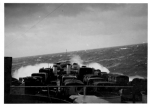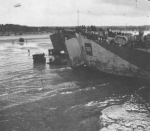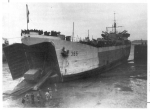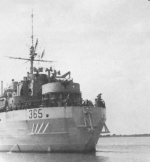Click On Image
For Full Size Image |
Size |
Image Description |
Source |
 |
52k |
HM LST-365 underway in rough seas with a full cargo of vehicles on deck, date and location unknown. |
Lubin Poulton for his father Albert Harry Poulton (Ginger) HM LST-365 |
 |
56k |
HM LST-365 center, and HM LST-320 left, high and dry on 'Sword' beach, Normandy, while unloading, June 1944 |
Robert Hurst |
 |
90k |
HM LST-365 and HM LST
-368 landing equipment and material at Normandy, June 1944. |
Robert Hurst |
 |
76k |
HM LST-365 disembarking German Prisoners of War at Southampton, UK, date unknown. |
Lubin Poulton for his father Albert Harry Poulton (Ginger) HM LST-365 |
 |
35k |
HM LST-365 bringing much needed supplies to Guernsey after its liberation in May 1945. |
Ed Storey |
 |
77k |
HM LST-365 at Ostend, Belgian while delivering cargo of vehicles, date unknown, |
Lubin Poulton for his father Albert Harry Poulton (Ginger) HM LST-365 |
 |
74k |
 |
62k |
HM LST-365 moored at Tilbury, Christmas Eve 1944 |
Lubin Poulton for his father Albert Harry Poulton (Ginger) HM LST-365 |
 |
57k |
HM LST-365 anchored at Brunsbuttel, Germany, where the Kiel canal joins the River Elbe, May 1945. |
Robert Hurst |
 |
43k |
View from the bridge of HM LST-365 showing other LSTs in single line as they are about to enter the River Elbe, en-route to Hamburg, during Operation 'Doomsday', in May 1945. |
Robert Hurst |
 |
54k |
HM LST-365 at anchor in the Elbe River, May 1945. |
Lubin Poulton for his father Albert Harry Poulton (Ginger) HM LST-365 |
 |
64k |
HM LST-365 being welcomed by the people of Stavanger, Norway, June 1945. |
Robert Hurst |
 |
82k |
HM LST-365 moored pierside at Stavanger, Norway. June 1945. |
Lubin Poulton for his father Albert Harry Poulton (Ginger) HM LST-365 |














